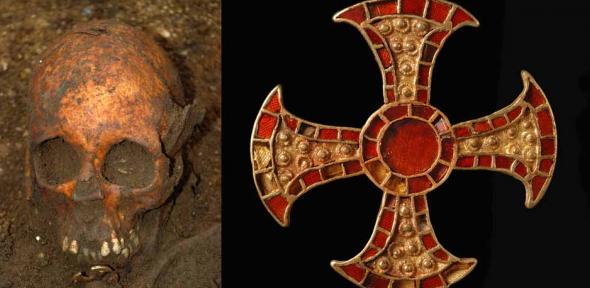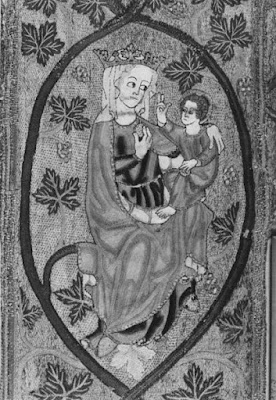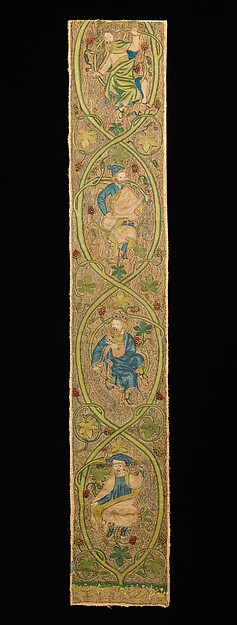Altar cross with gems or crux gemmata, made in Belgium, about 1250. From the workshop of Hugo de Oignies. In Victoria and Albert Museum, London. Museum number 244-1874.
http://media.vam.ac.uk/media/thira/collection_images/2008BU/2008BU7208_jpg_ds.jpg
Though I
keep mentioning the Dream of the Rood, I seriously doubt that many people, with
the exception of those few who might read this blog, have even heard of the
poem, let alone know how to read it in Old English. (I may be able to figure out a few
words. I am not facile with language and
so learning Old English is really hard for me.)
Given its Christian theme, it is not taught in school anymore. Without a special interest in things
Insular-Saxon and early medieval, it is mostly unknown now.
The only complete version is found in second
half of the 10
th or early 11
th century manuscript that
was found in the cathedral library of Vercelli Cathedral in Piedmont, northern
Italy. How the rather large manuscript,
made in England, came to be lodged in Italy where it was found in the 19
th
century is still not known. None of the
proposed theories including one that somehow the manuscript came into the
possession of Bishop Jacopo Guala Bicchieri (d. 1227) who had been papal legate
in England 1216–1218 explains the journey the manuscript made from England to
Italy. Bishop Bicchieri founded a rest
place or hostel for English pilgrims in Vercelli. The manuscript is rather heavy for a pilgrim
to carry for personal use. The writing
of the Vercelli book is in square miniscule and was copied from earlier
texts. The composition date is before
the 10
th century and probably much earlier, perhaps in the 8
th
century. The runic text on the Ruthwell
cross quotes lines that are very similar, but not quite identical, to the
version of Dream of the Rood found in the Vercelli manuscript. In addition, the inscription on the Brussels
Cross made during the 11
th century in northern England but now
housed in Belgium also bears great similarity to lines from the Dream of the
Rood. The inscription in translation
reads, “Rood is my name. Trembling once,
I bore a powerful king, made wet with blood.”
The Dream of the Rood may have had several
oral versions before it was written down.
The opening lines of the Dream of the Rood as they appear in the Vercilli manuscript.
http://www.english.ox.ac.uk/oecoursepack/rood/images/ver104b.jpg
A digital
version of the text is found at: http://vbd.humnet.unipi.it/beta/#104v
Numerous online translations include: http://www.dreamofrood.co.uk/frame_start.htm
http://www.english.ox.ac.uk/oecoursepack/rood/translations/hamer.html
http://lightspill.com/poetry/oe/rood.html
http://www.apocalyptic-theories.com/literature/dor/medora1.html
http://www.dmoz.org/Arts/Literature/World_Literature/British/Old_English/Individual_Poems/Dream_of_the_Rood/
http://www.english.ox.ac.uk/oecoursepack/rood/index.html
The poem is
set in the frame work of a dream that the poet had at night when all is
quiet. In the first part of the poem,
the poet dreams of a beautiful gem-covered cross of gold applied over
wood. Beneath the gold and jewels, a
crux
gemmata, is the real blood stained cross on which Jesus was crucified. The Saxons did not practice crucifixion as a
form of punishment, and so the cross was unknown to pagan Saxons, though the
gallows was used for capital punishment.
The dreamer at first compares the cross to the gallows that has become a
victory-beam. The dreamer is “stained
with sins, wounded with wickedness.” The
dreamer saw “the tree of glory adorned with drapery, shining with joys, decked
with gold; gems had worthily wrapped the All-Wielder's tree.” [Note: I am
borrowing freely from the translation of Eleanor Parker, PhD as it appears on
her blog, A Clerk of Oxford, http://aclerkofoxford.blogspot.co.uk/. I am no linguist but I relish her neologisms
that attempt to give one a sense of the constructed words of the original Old
English.] Beneath the fairness of the
crux gemmata, the dreamer sees the cross bleeding from its right side. This recalls the piercing of Jesus’ side by a
Roman soldier as told in John 19.34.
Frequently it is Jesus’ right side that is shown as pierced in Christian
iconography, but crucifixes and drawings of the Crucifixion in manuscripts of
northern Europe date from a couple of centuries later than the composition of
Dream of the Rood. (The earliest crucifix in northern Europe is the Gero
Crucifix in Cologne Cathedral made about 965-70.
) The dreamer’s vision shifts between the
bejeweled cross and the bloody gore when the cross speaks.

Crucifixion of Jesus with St. Mary and St. John. British Library Harley 2904 f. 3v. Ramsey Psalter. Made 980-1000 in Winchester, south England probably for use in the Benedictine monastery of Ramsey. This appears to be the oldest manuscript crucifixion scene made in England. It has many features the recall the Utrecht Psalter made in the 9th century in Europe. The drapery style referred to as "agitated" is typical of Winchester. http://molcat1.bl.uk/IllImages/NOF/big/033HRL000002904U00003V00.jpg
The cross
speaks as an old man recalling the memory of being cut down and carried on
men’s shoulders until it was affixed to a hill.
The Cross sees Jesus, the Savior of the world as a young hero who
embraces his crucifixion with resolve as a ransom for mankind. Unlike the cross of Venantius Fortunatus’
poem that is asked to relax its sinews, the Cross of the Dream is firm and
steadfast. The cross could have “felled
all those enemies” that crucified the “young lord” “but stood fast.” Christ is the young triumphant warrior even
when humiliated with death upon a cross. “I trembled when that man [Christ] embraced
me, yet I dared not bow to the earth, fall to earth's fields; I had to stand
fast.” (quotations again Dr. Parker’s translation) The cross raised up the Lord, the noble
king. The Cross then spoke of the
unhealing wounds of malice created by the nails used for the Crucifixion . The Cross was drenched in the blood of Jesus
before he died. The Cross watched as “All
creation wept, lamented the king’s fall. Christ was on the cross.” The steadfast cross is forsaken by the
soldiers, left alone, wounded and wet, while the body of the dead (limb-weary)
Jesus awaited burial.
In the poem there is the tension between the
beauty of the gold and jeweled cross and the
rough, grim, bloody wooden cross.
There is also the tension between the solidity of the dead wooden cross,
the instrument of death, and the weakness, fear, and trembling that the living
cross experiences as a sentient being, aware of the pain, suffering and
sacrifice of Jesus. Father G. Ronald
Murphy, SJ, refers to this as a "double identity." Father Murphy refers to this as an especially
Germanic feature where the cross as gallows is contrasted with the
"compassionate and so-suffering tree of rescue." It is the trembling and suffering wood that
recalled the long-suffering world tree Yggdrasil of Nordic myth. (G. Ronald Murphy, SJ. Tree of Salvation: Yggdrasil and the Cross of the North. (2013) Oxford and New York, Oxford University Press, pp. 125-153.)
The Cross
watched the sepulcher being dug and the body placed there before the
Resurrection. Then the poet reveals that
he knows the story of the discovery of the cross by Helena, the mother of
Emperor Constantine. The Cross is cut
down and thrown in a deep pit where it was buried. Later the cross was found by friends and
servants of the Lord who dug up the cross and adorned the remnants with gold
and silver. The Cross went on to say
that once an instrument of cruel torture and death, the Cross is now an
instrument of healing. The Cross orders
the dreamer to reveal the dream:
that you
tell men about this vision:
reveal with
words that it is the tree of glory
on which
almighty God suffered
for
mankind's many sins
and Adam's
ancient deeds.
Death he
tasted there; nevertheless, the Lord rose again
with his
great might to help mankind.
He ascended
into heaven. He will come again
to this
earth to seek mankind.
on doomsday,
the Lord himself,
almighty
God, and his angels with him,
so that he
will then judge, he who has the power of judgement,
each one of
them, for what they themselves have
earned here
earlier in this transitory life. (Elaine
Treharne translation)
The third section returns to the
poet’s prayers and hopes for a place in Paradise.
and I for myself expect
each of my
days the time when the Lord’s rood,
which I here
on earth formerly saw,
from this
loaned life will fetch me away
and bring me
then where is much bliss,
joy in the
heavens, where the Lord’s folk
is seated at
feast, where is bliss everlasting;
and set me
then where I after may
dwell in
glory, well with those saints
delights to
enjoy. May he be friend to me
who here on
earth earlier died
on that
gallows-tree for mankind’s sins.
He loosed us
and life gave,
a heavenly
home…(Glenn translation)
The
splendor of a Saxon hall is recalled in Dream of the Rood, far different from a
first century cooking fire of one-roomed house in dusty Palestine. The cross became a powerful and deeply
influential image in Saxon art and poetry.
The cross was the promise of salvation at death and the messenger that:
will fetch
me from this feeble life
and bring
me to where there is great bliss,
joy in
heaven, to join the Lord's people
always
sitting in unceasing bliss. (Leech translation)
The vines and trunks of Jesse Trees
of the 12th century onward are luxuriant with their leaves, flowers,
fruit, in various combinations. They are
not the solid shaft of high crosses.
They are not the tree cross of the hero young warrior. But they do draw upon the ancient idea of the
cross as tree of life.
In the
British Library is a manuscript psalter made in Winchester, England after 1073
or so but before 1099 with a drawing of the Crucifixion with Sts. Mary and John
that has a rough-hewn green wooden cross.
I do not intend to follow that path just yet. This was just a reminder that the cross of
death is also the tree of life.
British Library. Arundel Psalter f. 12v. Made about 1060 at Winchester, England.
http://molcat1.bl.uk/IllImages/NOF/big/011ARU000000060U00012V00.jpg
The
Vita Adae et Evae (Life of Adam
and Eve) in Latin dates from the 10th century.
It was originally a Jewish legend the extended
the story of Adam and Eve and the Fall.
It continued the story until Adam’s and Eve’s deaths and the writing of
their lives by Seth on stellae. The
parts of the story include:
a. Adam and Eve after the expulsion from the Garden of Eden,
b. Penitence of Adam in the Jordan River and Eve in the Tigris
river,
c. Adam blames Eve for the Fall and the birth of Cain,
d. The death of Abel,
e. Adam’s version of the expulsion with the vision of archangel
Michael from the Garden of Eden as told to Seth,
f. Adam at age 930 years as he is ill and death approaches,
g. Adam’s short version of the Fall as told to his children,
h. Adam in pain commands Eve and Seth to get him the oil of mercy
from the Tree of Life,
i. Eve and Seth encounter the serpent and Seth is bitten,
j. Arrival at Paradise where Eve and Seth beg Archangel Michael of
the Oil of Mercy, and Michael’s refusal,
k. Return to Adam with spices nard, crocus, calaminth, and cinnamon. Depending of the version they also may have
branches as well.
l. The death of Adam. God
gives his soul to Michael until Judgement Day.
m. The burial of Adam and Abel,
n. Death of Eve and her funeral,
o. The recording of the life of Adam and Eve,
p.
A final potpourri of stories about the nature of Adam, the
formation of Adam from soil brought by the archangels Michael, Gabriel,
Raphael, and Uriel from the four corners of the earth to Bethlehem, and the
naming of Adam.
These are not in all versions.
One part of
the legend gets carried over in the Legend of the (Holy) Rood or De ligno
sancte crucis, and therefore of particular interest when tracing the
origins of the wood of the Jesse Tree. I
am skipping ahead with the rood legends and then I will come back to the
finding of the Cross in the homilies of Aelfric and poem Elene,
even though both are older that the Legend of the Rood.
Usually the
first part of the story of the multipart story is about Seth, the son of Adam,
seeking the oil of Mercy for his dying father.
When Adam was old and in pain at aged 930 years, he sent Eve and his son
Seth back to the gates of Paradise to beg for oil from the Tree of Mercy to
anoint himself and ease the pain. Adam
commands Eve, “Rise, go with my son, Seth, near to the gates of paradise and
cast dust on your heads, and prostrate yourself on the ground,lamenting in the
sight of God. Perhaps he will take pity
and send his angel over to the tree of his mercy from which flows the oil of
life, and will give you a little of it with which to anoint me so that I may
have rest from these pains with which I am consumed.”
The angel
Michael met them and did not give them the requested oil. Instead, they were given a branch and sweet
smelling spices. Adam died and his
children mourned him. Then Seth saw the
hand of God give the body of Adam to the angel Michael. The angels Michael and Uriel buried Adam and
his son Abel in Paradise. Six days later
Eve died. Seth and his brothers and
sisters mourned her for only six days because of the instruction from the angel
Michael. Another version of this tale
has Seth looking into Paradise and seeing in a large tree at the center of the
garden the Virgin and infant Jesus. Upon
Seth’s reporting this sight to his dying father, Adam exclaims, “Blessed are
you, O Lord, for now I know truly that a virgin will conceive a son who will
die on the cross, whence we shall all be saved.”
One such
story is in the Holy Rood legend(s) dating perhaps from the 11th century and
found in a 12th century vernacular Old English manuscript at the Bodleian
Library (Bodley 343), Oxford.
The story starts with Moses finding three rods/trees in the desert after the
Red Sea crossing. He was asleep and
three rods sprung up during the night.
One was at his head and one was at his right and left. The trees are cypress, pine, and cedar. At first, Moses is afraid of the wood. Another version has Moses recognizing the
three wands as a symbol of the Trinity.
After Moses discovers that the rods have to power to sweeten bitter
water, he takes the three rods with him.
David carried the trees to Jerusalem where they were placed in a pool of
bitter water. The three become one
mighty tree that grew in David’s garden, and, on which, David hung 30 silver
hoops. Solomon cut down the tree to use
in building the Temple but the wood was always the wrong length. The wood would get longer or shorter than
what was needed. So the tree was put in
the Temple. The thirty silver hoops were
made into thirty plates that hung in the temple. The silver eventually came to Judas, the
betrayer of Jesus, as 30 pieces of silver (Matthew 26.15). The tree remained in the Temple in Jerusalem
and many miracles were associated with it.
Eventually Caiaphas ordered that three hundred men get the tree to make
the cross for Jesus. None of the three
hundred men could move the tree. So, a
section of wood was cut from the tree for the cross for Jesus.
The Legend
of the Holy Rood picks up later with Helena, the mother on Constantine, coming
to Jerusalem. She went into the temple
and saw wood there that was left from the cross that had previously been made
for Jesus. She was told by a voice of an
angel to cut the remaining wood into four pieces, each 10 ells in length. These four pieces were to be sent to the four
corners of the earth. Helen found the cross
of Jesus’ crucifixion and the cross on which the robber was crucified, the wood was carried with great honor to
Constantinople.
When Helena entered the city, a dead man was
brought to her, and he was made alive by the wood from the true cross.
A week
later, Constantine went to Jerusalem. Helena gave him two pieces of the Holy
Cross. One piece went to Jerusalem, one
piece to Alexandria, one piece to Rome with Pope Silvester, and the final piece
went to Constantinople. Three days after
the finding of the Cross, Judas, the Jew who helped Helena find the Holy Rood,
gave Helena the five nails used in the crucifixion of Jesus. An angel again
come to Helena and told her to make a bridle for her son from the five nails
used for the crucifixion. The mouth of
the horse wearing the bridle had a great flame coming from it. As a consequence, the people seeing it were
terrified and accepted Christianity. The bridle sped the spread of
Christianity.
It is clear
even from this summary that not all the story as we now have it hang
together. There are inconsistencies both
within the story and between the story and the Gospels.It would seem that parts were added or parts lost. It appears that the story or stories had different probable oral traditions before being written down and the versions were never completely reconciled.

















